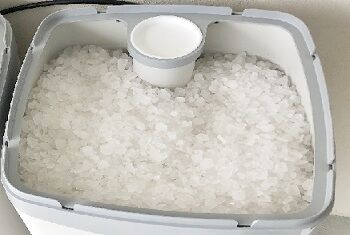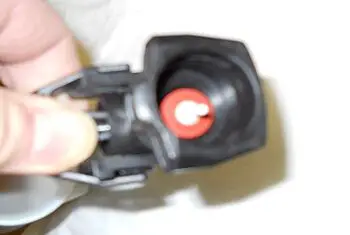You go to check your water softener to see if you need to add salt to the brine tank and notice that you don’t see any water in the brine tank. Isn’t there supposed to be at least some water in the bottom of your brine tank?
You may not see water in your water softener brine tank if the water level is below the salt level, your water softener does not refill the brine tank after regeneration, your water softener has no supply of water, a water valve is not opening or there is an obstruction in the brine tube.
Not seeing any water in your water softener brine tank is not uncommon and certainly does not mean that there is a problem with your water softener.
Check for these common reasons that you may not see any water in your water softener brine tank and you will very likely find that the reason that you do not see any water in your water softener brine tank has a simple solution.
Why You May Not See Any Water In Your Water Softener Brine Tank.
- The Water Level Is Below The Salt Level In The Brine Tank
- Your Water Softener Only Adds Water To The Brine Tank During Regeneration
- Your Water Softener Is Regenerating And Has Not Added Water Back Into Its Brine Tank
- The Water Supply To Your Water Softener Has Been Shut Off
- Your Water Softener Was Put Into Bypass Mode During Its Regeneration
- Your Water Softener Lost Power During Regeneration
- The Brine Tank Fill Tube Is Kinked, Clogged, Or Blocked
- The Brine Tank Valve Is Sticking
You May Not See Any Water In Your Brine Tank Because It Is Covered By Salt.

This is a very common question that I get because many people expect to see their brine tank full of water with the salt level below the level of the water.
As a rule of thumb, you should always keep the level of salt above the level of water in a water softener brine tank.
A properly sized water softener should only need the water level in its brine tank to be about ⅓ to ½ of the way up the brine tank.
This means that if you fill the brine tank with salt, you will not be able to see how high the water level is because the water level is beneath the salt level.
Some Water Softeners Use A “Dry Brine Tank” Regeneration Process.
Unlike more traditional water softeners that add water back into their brine tank at the end of their regeneration process so that there will be brine ready for the next regeneration, some newer water softeners only add water to the brine tank a few hours before regeneration.
Check Out This Quick Video About How A “DRY” Brine Tank Water Softener Works
Because “Dry Brine Tank” water softeners only add water to their brine tanks shortly before the water softener will need to use the brine, you will only see water in the brine tank for a short time before the water softener regenerates.
So if you go to add salt to your water softener brine tank and do not see any water in the tank even when the level of salt is low, your water softener is probably working just fine if your water is soft and it has been used salt, it just doesn’t add water to use the salt until it is ready to use it.
Your Water Softener Brine Tank Will Be Emptied During Regeneration.
Early on during a water softener’s regeneration process, it will draw the brine from its brine tank and it will not add water back into the brine tank right away so there will be a period of time when you should not see any water in your water softener brine tank.
In order for a water softener to regenerate its water softener resin, it needs to draw the brine from its brine tank and run the brine through its water softener resin to perform a process called ion exchange.
When the water softener draws the brine out of the brine tank, it will then rinse away excess brine before adding water back into the brine tank unless it is designed to only add water to the brine tank just before regeneration if it is a “DRY” brine tank system.
Is The Water To Your Water Softener Turned On?
In order for there to be water in your brine tank, there has to be water getting to your water softener.
If your water softener has been bypassed or if the water supply to the water softener has been shut off, the water softener will not be able to add water back into its brine tank.
Check your water softener bypass to make sure that it is in the “SERVICE” position which will allow water into the water softener which will allow the water softener to add water to its brine tank.

Make sure that water valves are open going into your water softener but make sure that if there is a three-valve bypass valve going to your water softener the bypass (usually the middle valve) is closed.

If you bypassed your water softener while it was in its regeneration cycle, there might be no water in your brine tank because the water softener has drawn the brine out of the brine tank and was bypassed before it was able to refill the brine tank.
Check the brine tube for kinks or restrictions.

Have you moved around some items that are close to your water softener lately?
I have seen that people have moved some objects that are close to their water softener and in doing so they have pinched or kinked the brine tube that goes from the water softener to the brine tank.
Usually, you can correct the problem by simply moving the item out of the water and making sure that the brine tube is clear of obstacles that may interfere with the brine tube.
There also might be some sort of restriction in the brine line.
Sometimes salt or debris in your brine tank can get lodged in the brine line or block the opening of the brine float assembly that allows water to flow into the brine tank.
Check down the brine float tube for salt build-up and make sure that the brine float assembly is free of obstruction on its sides as well as the bottom of the assembly.
Make Sure That The Brine Float Valve Is Opening Freely.
The Brine float valve is the valve that opens and closes to draw the brine out of the brine tank as well as put new water back into the brine tank to make more brine.

I have rarely found a brine float valve to malfunction, but it can happen from time to time.
Salty crusting on the brine float valve or dirt that has settled on the brine float valve can cause the brine float valve to seize and prevent your water softener from refilling your brine tank.
You can move your brine float up and down to see if your brine float valve is opening and closing correctly. Don’t remove the entire brine float assembly if you don’t have to because they can sometimes be tricky to get back in.
Understand What’s In Your Water!
Easily check that your water is free of hard minerals!
Know if your water contains dissolved iron!
Check the Total Dissolved Solids in your water!
Get more facts about your water!
To Sum Up!
Chances are that your water softener is working just fine even though you may not see any water in your brine tank.
Before you call a water softener service technician or try to solve the problem yourself, test your water for hardness with a water hardness test kit.
If the water is soft, your water softener has been using salt which means that there has been water in your brine tank.
If you find that your water is hard, you can check for these possible solutions before contacting your local water softener service technician.


Hi
My culligan water softener started hammering.
THere is no salt and no water in the brine tank,so unplugged
Can it flood?
Thanks,
Mike
Hello Mike and thank you for the question.
Unplugging a water softener does not stop water from flowing through it. Water could still leak through seals or valves within the system.
I recommend that you bypass the system using the bypass valve on the rear of the control valve. It is likely to be a large knob in the back of the top of the system that you can turn to stop water flowing through the system but still have water to the home.
If you have trouble locating the valve, contact your local Culligan dealer and they will talk you through it.
I hope this was helpful
Paul